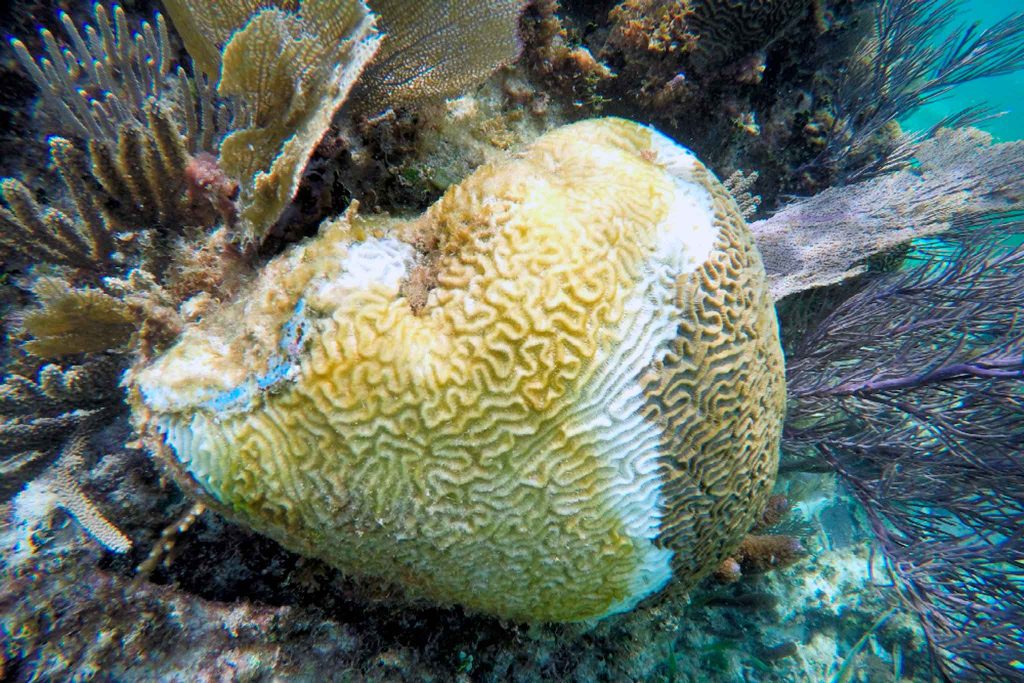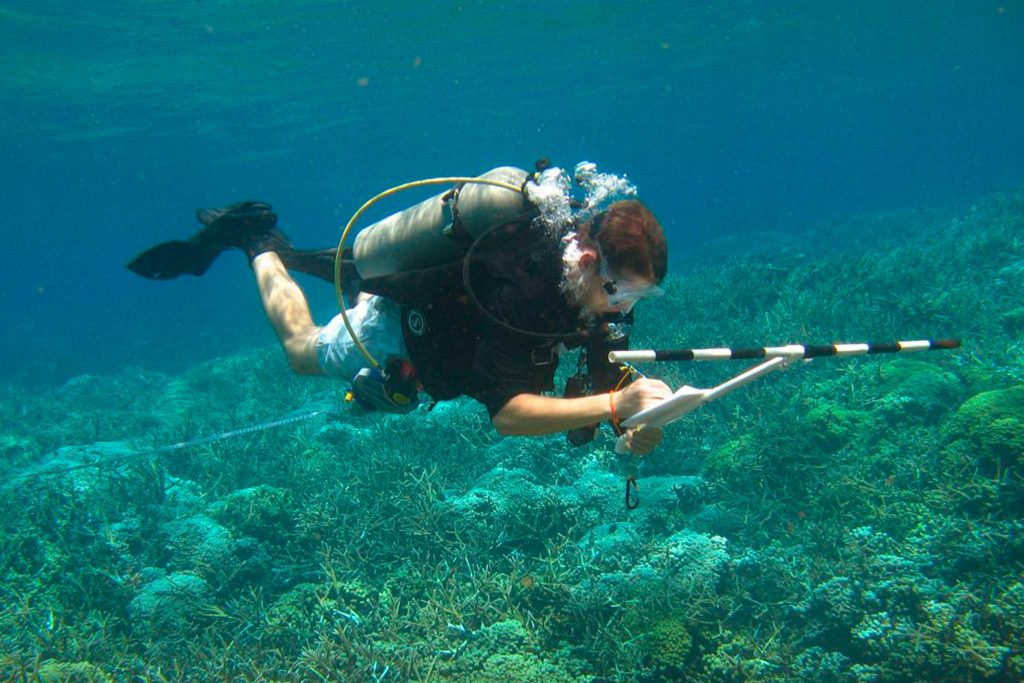The Mesoamerican Reef and the keys to save it
- Early this year, the Mesoamerican regional initiative healthy reef for healthy people, published its sixth report about the healthy status of the Mesoamerican Reef System (MAR).
- After the analysis of 286 different sites from Mexico, Belize, Guatemala and Honduras, concluded that the health of the system is poor, with an index of 2.5 out of 5, based in the status of coral and fleshy macro algae cover, as well as the biomass of herbivorous fish and commercial fish available in the region.
When we think about coral reef barriers, probably we think about white sand beaches, crystal clear turquoise waters and a tropical beverage in our hand. What we might not imagine, is that in Mesoamerica (south of Mexico, Belize, Guatemala and Honduras) we found the largest barrier reef in the Western Hemisphere and the second largest in the world. It is known as Mesoamerican Reef System (MAR)
It is home to 65 species of stony coral, 350 species of mollusks and more than 500 species of fish. Emblematic and seriously endangered species take refuge here, such as sea turtles, the queen conch, the Caribbean manatee and two types of crocodiles. The MAR is also the habitat of the whale shark, the largest fish in the world.
Consider as species in critical danger (CR) according to the criteria of the IUCN Red List of Ecosystems, the MAR represents a major benefit for marine wildlife and for human populations that inhabitant the coasts of the four countries. They are also a nursery for many species of fish, on which the economic activity of these coastal communities depends. As an example, according to the World Wild Fund for Nature (WWF), activities as fishing and tourism represents between US$210 and US$350 million annually only to the fishing industry of Belize. In Quintana Roo, south of Mexico, coral reef attract tourism, which represents 49% of their economic activity, and employees up to 34% of people on productive age. Just in that area the reefs contribute up to US$9 billion to the local economy, annually.
Overexploitation of resources, source of reef environmental deterioration

Coral reefs are key to the ecological balance of the Caribbean Sea. Photo: Marek Okon/Unsplash
The report of Healthy Reefs for healthy people analyzed 286 sites, of which 104 are in Belize, 99 in Mexico, 73 in Honduras and 10 in Guatemala. Of all of them, only 1% is in excellent condition, 8% in good condition, and the rest are between fair and critical conditions. According to the 2020 report card, the number of sites classified as poor went from 37% (2018) to 46% (2020). In the same period of time, the number of good sites decreased from 13% to 8%. Guatemala and Honduras are the countries where the situation is most critical, due to the loss of biomass from commercial and herbivorous fish.
“There is a very bad fish regulation within the four countries. The loss (of health) that we are witnessing is due to industrial and artisanal overfishing,” said Ian Drysdale, coordinator of Healthy Reefs in Honduras. “Sadly, fishing industry has a lot of political and economic power, and their interference makes it really difficult to protect our marine ecosystems,” he added.
In October of 2018, Mexico´s Government added 10 species of parrot fish to its national record of protected species. In February of 2020, Guatemala´s Government did the same, including also butterfly fish, angel fish and surgeon fish. “We have fished so well at the top of the food chain (sharks, mere, etc.) and now we are fishing herbivores, fishes without any commercial value,” said Drysdale. This herbivores fishes can help to control coverage of fleshy macro algae that competes with coral for physical space. Without them, the corals suffer. “Everything is interconnected. There is no way that you remove one piece of the puzzle without affecting the rest,” he added.
Guatemala and Belize declared, during 2020, the bank known as Cayman Crown, located between the two countries, as an area of great importance for the MAR. In Guatemala it was declared a temporary closed fishing zone for ten years, while Belize added it to the Sapodilla Cayes Marine Reserve, which now totals an area of more than 500 square miles. Conservationists in Belize hope that these actions will lessen the threat of illegal cross-border fishing.
Fish consumption is also linked to cultural traditions, a factor that must be taken into account when creating conservation strategies, said Nallely Hernández, regional deputy director of the National Commission for Natural Protected Areas (CONANP).
Climate change and coral diseases

The exact causes of White Syndrome are still unknown, but it is believed to be poor water quality and pollution. Photo: Melinda Soto/CONANP
The increase in ocean temperatures, associated with climate change, is negatively impacting the biological processes of the reefs. In 1998, the National Office for Oceanic and Atmospheric Administration (NOAA), through its coral reef watch program, recorded a massive bleaching event on the reefs of the Mesoamerican Caribbean. Temperatures 1°C or 2°C higher than normal, generate thermal stress in the corals, which causes them to expel the algae that provide them with food and coloration. This is an event known as coral bleaching and, if heat stress goes on too long, it can lead to coral death.
Until 2014, NOAA had only recorded two massive bleaching events in the Caribbean (1998 and 2011), however, meteorological experts believe, based on their constant observations, that coral bleaching could become annual events, putting their survival at serious risk.
On top of that, still without clear knowledge of its origin, another threat looms over the reef: the White Syndrome disease, which weakens coral tissues causing their death, appeared on the coasts of Florida in the fall of 2014 and has since spread to the Mexican Caribbean, the Dominican Republic, Jamaica and Puerto Rico. At the beginning of the year, it was reported that corals in Belize and the Bahamas already show signs of being infected.

The tourist activity also generates dangers for the health of the corals. Photo: Melina Soto/CONANP
It was in the Yucatan Peninsula where the disease was detected in 2018, and to date it has caused the death of up to 98% of individuals of some coral species. “When we approach the loss of 90% to 98% of the individuals of a particular species, we could well speak of the definitive disappearance of this species,” said Hernández, who co-wrote the White Syndrome Action Plan in the Reefs of the Caribbean of Mexico.
With CONANP´s own resources and supported by Autonomous University of Mexico (UNAM) and Florida State University, Hernandez mentioned that a study was performed with the samples of 52 coral sites along the peninsula of Quintana Roo. “It showed that 3 out of 50 species of coral where the most affected. It is inferred that white syndrome could be a bacteria or a virus, but because the ocean is loaded with plenty of microscopic life, it is really hard to isolate the exact one,” she said.
But what they did accomplish, is that now they know the difference between the bleaching and the diseases behavior patterns, once the corals are infected. “At first, we saw that the disease spread radially and began to the edges of the colony. Later, we realized that it could move from one side to the other, or everywhere. Whitening tends to be more localized and moves in a certain direction,” Hernandez commented.
Underwater gardening and community participation

Research is key to understanding the dangers that SAM faces, and thus creating and implementing solutions. Photo: CONANP
The solutions for all of are quite complex, said Hernández, since it is necessary to consider “the social and economic part”, as well as cultural and traditional aspects. Among the population there is “ignorance of how an ecosystem works,” so they live under “the belief that resources are inexhaustible.” This, in the end, does a lot of damage to natural ecosystems.
Faced with these emergencies, since 2016 some solutions have been put into practice to counteract the loss of coral mass. Coral seeding is a process of extracting small fragments from well-preserved colonies, which are then transferred to the laboratory to be cultured in controlled environments and then reinserted into damaged colonies. In the Mexican Caribbean, the objective of the authorities is to “plant” some 268 thousand feet of coral before 2022.
Though, this is a costly practice ($400,000 per hectare) and loses effectiveness if it is not accompanied by severe actions in the treatment of wastewaters and water pollution. “Even if you plant a coral but have poor water quality, this is not going to work,” Hernández said. For measures like this to have a better effect, the ideal is to apply to the White Syndrome Action Plan, which has already been shared with Belize, Guatemala and Honduras, and includes measures for water treatment, stricter regulation in fishing practices and other actions to benefit reef health.
In the end, both Hernández and Drysdale agree that community participation is key, as they must “make their own” these issues, if they want to make a change. “The solution is in the daily collective. We need to make adjustments in the whole system, in order to understand the positive impact that we can generate with changes in our daily habits,” Hernández concluded.